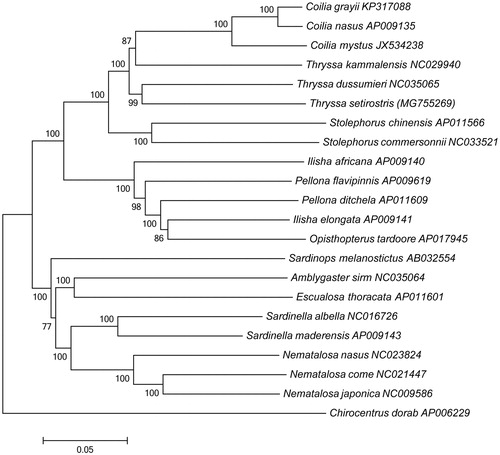Abstract
The complete mitochondrial genome of Thryssa setirostris has been determined. The whole sequence was 16,926 bp in length and included 13 protein-coding genes, 22 transfer RNA genes, 2 ribosomal RNA genes, and 1 control region (D-loop). The overall base composition is A 29.88%, C 29.23%, G 16.77%, T 24.02%, with a slightly A + T bias of 54%. With the exception of ND6 and eight tRNA genes, all other mitochondrial genes are encoded on the heavy strand. Phylogenetic tree was constructed based on 13 protein-coding genes sequences of 21 clupeoidei species, and the result showed that T. setirostris is most closely related to T. dussumieri. These mitogenome sequence data will be useful for population genetics and phylogenetic analysis of the Clupeoidei.
Thryssa setirostris, which belongs to Engraulinae, Engranlidae, Clupeoidei, is distributed in the western Indo-Pacific (Whitehead et al. Citation1988). So far, the complete mitochondrial genome (mitogenome) sequence of this species has not been reported yet. In order to find new DNA markers for the future research of population genetics and phylogenetics and taxology, we determined the complete mitogenome of T. setirostris (GenBank accession number MG755269) by PCR amplification and primer walking sequence method.
Thryssa setirostris was collected from the South China Sea (18°12′26″N 109°38′20″E) and stored in a refrigerator of −80 °C with accession number 20171209CHLT. The specimen was identified based on the morphologic features and COI gene. Muscle tissues of individual specimens for molecular analysis were reserved in ethanol absolute. Whole genomic DNA was extracted by using the phenol-chloroform method (Barnett and Larson Citation2012). Universal primers (Ivanova et al. Citation2007) were designed from the conserved regions of the complete mitochondrial genome sequences of 28 Clupeiformes species from GenBank database. Sequence alignment was conducted by BioEdit (Hall Citation1999). The phylogenetic tree involving 21 Clupeoidei species was constructed using the neighbour joining (NJ) methods based on the 13 protein-coding genes. The NJ trees were obtained with 10,000 bootstrap replications using MEGA5 (Tamura et al. Citation2011).
The complete mitochondrial genome of T. setirostris was 16,926 bp in length, consisting of 13 protein-coding genes, 22 transfer RNA genes (tRNA), 2 ribosomal RNA genes (12S rRNA and 16S rRNA), and 1 control region (D-loop). Except ND6 and eight tRNAs (Gln, Ala, Asn, Cys, Tyr, Ser, Glu, Pro), other genes were encoded on the heavy strand. The mitochondrial base composition is A 29.88%, C 29.23%, G 16.77%, T 24.02%, respectively. The A + T content (54%) is higher than G + C content, in common with other Clupeoidei mitogenomes (Li et al. Citation2012; Bo et al. Citation2013; Zhang et al. Citation2016). Twelve protein-coding genes start with ATG except COX1, which start with GTG. For the stop codon, ND6 ends with AGG, seven genes (ND1, COX1, ATP8, ATP6, COX3, ND4L, ND5) end with TAA, ND2, ND3, COX2, ND4, and CYTB with an incomplete TA or T. The 12S rRNA (952 bp) is located between tRNAPhe and tRNAVal genes, and 16S rRNA (1587 bp) is located between tRNAVal and tRNALeu genes. The control region (D-Loop) typically located between tRNAPro and tRNAPhe genes, is 1282 bp in length. Two tandem repeat sequences were observed in the control region (D-Loop). The shortest motif was 39 bp with five repeats, and the longest motif were 50 bp with two repeats. Such a symbolic structure of the control region are also frequently observed in other teleost fishes (Guo et al. Citation2003; Gong et al. Citation2015).
The phylogenetic tree () was constructed using the neighbour joining (NJ) method based on the 13 protein-coding genes of 21 clupeoidei species. The result shows that T. setirostris is most closely related to T. dussumieri. We expect the present results will further facilitate for the study on the taxonomy, population genetic structure, and phylogenetic relationships of Clupeoidei.
Disclosure statement
The authors report no conflicts of interest. The authors alone are responsible for the content and writing of the paper.
Additional information
Funding
References
- Barnett R, Larson G. 2012. A phenol-chloroform protocol for extracting DNA from ancient samples. Methods Mol Biol. 840:13–19.
- Bo Z, Xu T, Wang R, Jin X, Sun Y. 2013. Complete mitochondrial genome of the Osbeck's grenadier anchovy Coilia mystus (Clupeiformes, Engraulidae)). Mitochondrial DNA. 24:657–659.
- Gong L, Shi W, Si LZ, Wang ZM, Kong XY. 2015. The complete mitochondrial genome of peacock sole Pardachirus pavoninus (Pleuronectiformes: Soleidae) and comparative analysis of the control region among 13 soles. Mol Biol. 49:408–417.
- Guo X, Liu S, Liu Y. 2003. Comparative analysis of the mitochondrial DNA control region in cyprinids with different ploidy level. Aquaculture. 49:25–38.
- Hall T. 1999. BioEdit: a user-friendly biological sequence alignment editor and analysis program for Windows 9598NT. Nucl Acids Symp Ser. 41:95–98.
- Ivanova NV, Zemlak TS, Hanner RH, Hebert PDN. 2007. Universal primer cocktails for fish DNA barcoding. Mol Ecol Notes. 7:544–548.
- Li M, Zou K, Chen Z, Chen T. 2012. Mitochondrial genome of the Chinese gizzard shad Clupanodon thrissa (Clupeiformes: Clupeidae) and related phylogenetic analyses. Mitochondrial DNA. 23:438–440.
- Tamura K, Peterson D, Peterson N. 2011. MEGA5: molecular evolutionary genetics analysis using maximum likelihood, evolutionary distance, and maximum parsimony methods. Mol Biol Evol. 28: 2731–2739.
- Whitehead PJP, Nelson GJ, Wongratana T. 1988. FAO species catalogue. v. 7: Clupeoid fishes of the world (Suborder Clupeoidei). An annotated and illustrated catalogue of the herrings, sardines, pilchards, sprats, shads, anchovies and wolf-herrings. pt. 2: Engraulididae. FAO Fish Synop. 125:305–579.
- Zhang N, Song N, Gao T. 2016. The complete mitochondrial genome of Coilia nasus (Clupeiformes: Engraulidae) from Ariake Sea. Mitochondrial DNA A DNA Mapp Seq Anal. 27:1518–1519.

